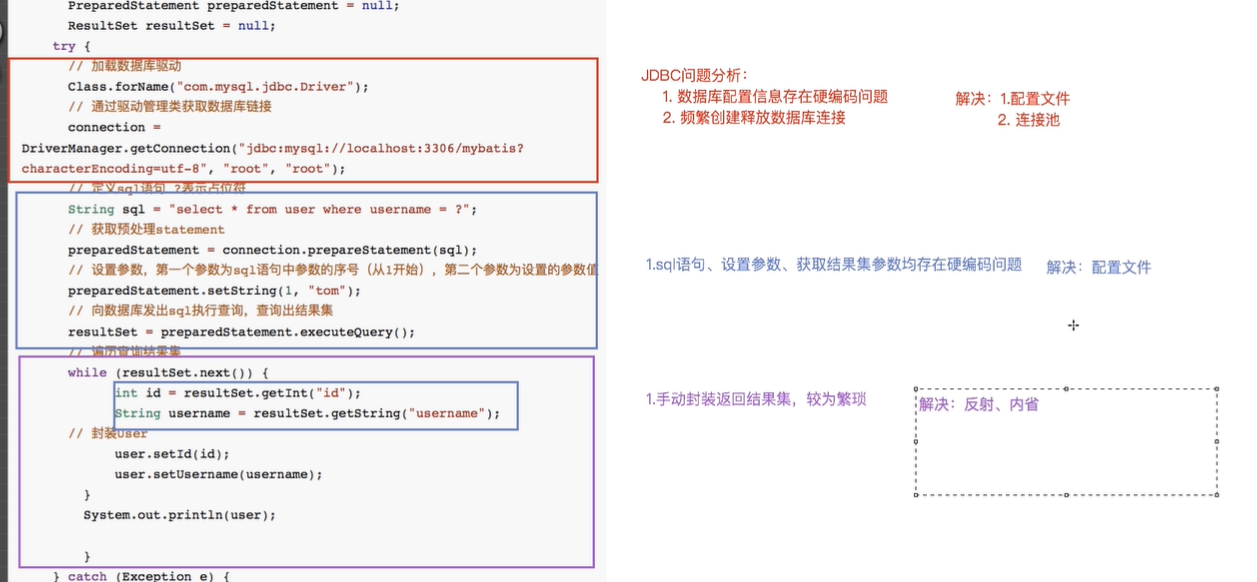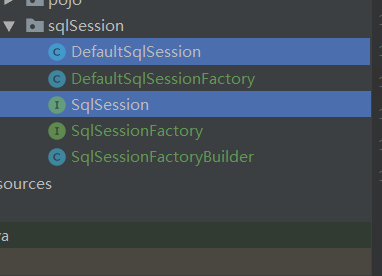⾃定义持久层框架
分析JDBC操作问题
public static void main(String[] args) {
Connection connection = null;
PreparedStatement preparedStatement = null;
ResultSet resultSet = null;
try {
// 加载数据库驱动
Class.forName("com.mysql.jdbc.Driver");
// 通过驱动管理类获取数据库链接
connection =
DriverManager.getConnection("jdbc:mysql://localhost:3306/mybatis?
characterEncoding=utf-8", "root", "root");
// 定义sql语句?表示占位符
String sql = "select * from user where username = ?";
// 获取预处理statement
preparedStatement = connection.prepareStatement(sql);
// 设置参数,第⼀个参数为sql语句中参数的序号(从1开始),第⼆个参数为设置的参数值
preparedStatement.setString(1, "tom");
// 向数据库发出sql执⾏查询,查询出结果集
resultSet = preparedStatement.executeQuery();
// 遍历查询结果集
while (resultSet.next()) {
int id = resultSet.getInt("id");
String username = resultSet.getString("username");
// 封装User
user.setId(id);
user.setUsername(username);
}
System.out.println(user);
}
} catch (Exception e) {
e.printStackTrace();
} finally {
// 释放资源
if (resultSet != null) {
try {
resultSet.close();
} catch (SQLException e) {
e.printStackTrace();
分析JDBC操作问题 解决方案
1.数据库配置信息存在硬编码问题 1.配置文件
2.频繁创建释放数据库连接 2.连接池解决

JDBC问题总结:
原始jdbc开发存在的问题如下:
1、 数据库连接创建、释放频繁造成系统资源浪费,从⽽影响系统性能。
2、 Sql语句在代码中硬编码,造成代码不易维护,实际应⽤中sql变化的可能较⼤,sql变动需要改变java代码。
3、 使⽤preparedStatement向占有位符号传参数存在硬编码,因为sql语句的where条件不⼀定,可能多也可能少,修改sql还要修改代码,系统不易维护。
4、 对结果集解析存在硬编码(查询列名),sql变化导致解析代码变化,系统不易维护,如果能将数据 库记录封装成pojo对象解析⽐较⽅便
自定义持久层框架设计思路

自定义持久层框架实现步骤
1. 环境基本部署搭建


第一步 :引入持久层框架依赖
1.zdyMybatis_test使用端:
<?xml version="1.0" encoding="UTF-8"?>
<project xmlns="http://maven.apache.org/POM/4.0.0"
xmlns:xsi="http://www.w3.org/2001/XMLSchema-instance"
xsi:schemaLocation="http://maven.apache.org/POM/4.0.0 http://maven.apache.org/xsd/maven-4.0.0.xsd">
<modelVersion>4.0.0</modelVersion>
<groupId>com.mytest</groupId>
<artifactId>zdyMybatis_test</artifactId>
<version>1.0-SNAPSHOT</version>
<properties>
<project.build.sourceEncoding>UTF-8</project.build.sourceEncoding>
<maven.compiler.encoding>UTF-8</maven.compiler.encoding>
<java.version>1.8</java.version>
<maven.compiler.source>1.8</maven.compiler.source>
<maven.compiler.target>1.8</maven.compiler.target>
</properties>
<dependencies>
<dependency>
<groupId>com.mytest</groupId>
<artifactId>zdyMybatis</artifactId>
<version>1.0-SNAPSHOT</version>
</dependency>
</dependencies>
</project>
2.zdyMybatis 框架端:
<?xml version="1.0" encoding="UTF-8"?>
<project xmlns="http://maven.apache.org/POM/4.0.0"
xmlns:xsi="http://www.w3.org/2001/XMLSchema-instance"
xsi:schemaLocation="http://maven.apache.org/POM/4.0.0 http://maven.apache.org/xsd/maven-4.0.0.xsd">
<modelVersion>4.0.0</modelVersion>
<groupId>com.homework</groupId>
<artifactId>mybatis</artifactId>
<version>1.0-SNAPSHOT</version>
<properties>
<project.build.sourceEncoding>UTF-8</project.build.sourceEncoding>
<maven.compiler.encoding>UTF-8</maven.compiler.encoding>
<java.version>1.8</java.version>
<maven.compiler.source>1.8</maven.compiler.source>
<maven.compiler.target>1.8</maven.compiler.target>
</properties>
<dependencies>
<dependency>
<groupId>mysql</groupId>
<artifactId>mysql-connector-java</artifactId>
<version>5.1.17</version>
</dependency>
<dependency>
<groupId>c3p0</groupId>
<artifactId>c3p0</artifactId>
<version>0.9.1.2</version>
</dependency>
<dependency>
<groupId>log4j</groupId>
<artifactId>log4j</artifactId>
<version>1.2.12</version>
</dependency>
<dependency>
<groupId>junit</groupId>
<artifactId>junit</artifactId>
<version>4.10</version>
</dependency>
<dependency>
<groupId>dom4j</groupId>
<artifactId>dom4j</artifactId>
<version>1.6.1</version>
</dependency>
<dependency>
<groupId>jaxen</groupId>
<artifactId>jaxen</artifactId>
<version>1.1.6</version>
</dependency>
</dependencies>
</project>
第二步 :添加配置文件
使⽤端:
提供核⼼配置⽂件:
sqlMapConfig.xml : 存放数据源信息,引⼊mapper.xml
Mapper.xml : sql语句的配置⽂件信息
sqlMapConfig.xml :
<configuration>
<!-- 当前使用5.7数据库进行配置 -->
<!--数据库配置信息-->
<dateSourse>
<property name="driverClass" value="com.mysql.cj.jdbc.Driver"></property>
<property name="jdbcUrl" value="jdbc:mysql://localhost:3306/mybatis_test"></property>
<property name="username" value="root"></property>
<property name="password" value="root"></property>
</dateSourse>
<!--存放mapper.xml的全路径-->
<mapper resource="UserMapper.xml"></mapper>
</configuration>
Mapper.xml :
<mapper namespace="com.mybatis.dao.IUserDao">
<!--sql的唯一标识:namespace.id来组成 : statementId-->
<select id="findAll" resultType="com.mybatis.pojo.User" >
select * from user
</select>
<!--
User user = new User()
user.setId(1);
user.setUsername("zhangsan")
-->
<select id="findByCondition" resultType="com.mybatis.pojo.User" paramterType="com.mybatis.pojo.User">
select * from user where id = #{id} and username = #{username}
</select>
</mapper>
具体实现
1)加载配置文件,根据配置文件路径,加载成字节输入流,存储在内存 创建 Resource类,方法 : public static InputStream getResourceAsSteam(String path)
package com.mybatis.io;
import java.io.InputStream;
/**
* @Author: denghy
* @DateTime: 2021/1/28 11:28
* @Description: TODO
* @package: com.mybatis.io
*/
public class Resources {
// 根据配置文件的路径,将配置文件加载成字节输入流,存储在内存中
public static InputStream getResourceAsSteam(String path){
InputStream resourceAsStream = Resources.class.getClassLoader().getResourceAsStream(path);
return resourceAsStream;
}
}
2)创建两个javaBean(容器对象)存放对配置文件解析的内容
MappedStatement : 映射配置类,存放解析的userMapper.xml内容
Configruation : 核心配置类,存放解析的sqlMapperConfig.xml内容
package com.mybatis.pojo;
/**
* @Author: denghy
* @DateTime: 2021/1/28 13:27
* @Description: TODO
* @package: com.mybatis.pojo
*/
public class MappedStatement {
private String id;
private String resultType;
private String paramterType;
private String sql;
public String getId() {
return id;
}
public void setId(String id) {
this.id = id;
}
public String getResultType() {
return resultType;
}
public void setResultType(String resultType) {
this.resultType = resultType;
}
public String getParamterType() {
return paramterType;
}
public void setParamterType(String paramterType) {
this.paramterType = paramterType;
}
public String getSql() {
return sql;
}
public void setSql(String sql) {
this.sql = sql;
}
}
package com.mybatis.pojo;
import javax.sql.DataSource;
import java.util.HashMap;
import java.util.Map;
public class Configuration {
private DataSource dataSource;
/*
* key: statementid value:封装好的mappedStatement对象
* */
Map<String,MappedStatement> mappedStatementMap = new HashMap<>();
public DataSource getDataSource() {
return dataSource;
}
public void setDataSource(DataSource dataSource) {
this.dataSource = dataSource;
}
public Map<String, MappedStatement> getMappedStatementMap() {
return mappedStatementMap;
}
public void setMappedStatementMap(Map<String, MappedStatement> mappedStatementMap) {
this.mappedStatementMap = mappedStatementMap;
}
}
3)用dome4j进行解析配置文件:
创建一个SqlSessionFactoryBuilder类,public SqlSessionFactory build(InputStream in) 方法
1. 使用deom4j 解析,将解析的内容存放在容器中
2 .SqlSessionFactory 创建 sqlSession对象,用到 工厂模式
1)使用dome4j 解析配置文件,并存放在configruation
XMLConfigBuilder xmlConfigBuilder = new XMLConfigBuilder();
Configuration configuration = xmlConfigBuilder.parseConfig(inputStream);
package com.mybatis.sqlSession;
import com.mybatis.config.XMLConfigBuilder;
import com.mybatis.pojo.Configuration;
import org.dom4j.Document;
import org.dom4j.DocumentException;
import org.dom4j.io.SAXReader;
import java.beans.PropertyVetoException;
import java.io.InputStream;
/**
* @Author: denghy
* @DateTime: 2021/1/28 14:41
* @Description: TODO
* @package: com.mybatis.sqlSession
*/
public class SqlSessionFactoryBuilder {
public SqlSessionFactory build(InputStream inputStream) throws DocumentException, PropertyVetoException {
//使用dome4j 解析配置文件,并存放在configruation
XMLConfigBuilder xmlConfigBuilder = new XMLConfigBuilder();
Configuration configuration = xmlConfigBuilder.parseConfig(inputStream);
//创建SqlsessionFatory对象,产生SqlSession
DefaultSqlSessionFactory defaultSqlSessionFactory = new DefaultSqlSessionFactory(configuration);
return null;
}
}
package com.mybatis.config;
import com.mchange.v2.c3p0.ComboPooledDataSource;
import com.mybatis.io.Resources;
import com.mybatis.pojo.Configuration;
import com.sun.javafx.scene.control.skin.ComboBoxPopupControl;
import org.dom4j.Document;
import org.dom4j.DocumentException;
import org.dom4j.Element;
import org.dom4j.io.SAXReader;
import java.beans.PropertyVetoException;
import java.io.InputStream;
import java.util.List;
import java.util.Properties;
/**
* @Author: denghy
* @DateTime: 2021/1/28 14:44
* @Description: 该方法就是使用dom4j对配置文件进行解析,封装Configuration
* @package: com.mybatis.config
*/
public class XMLConfigBuilder {
private Configuration configuration;
public XMLConfigBuilder() {
this.configuration = new Configuration();
}
public Configuration parseConfig(InputStream inputStream) throws DocumentException, PropertyVetoException {
Document document = new SAXReader().read(inputStream);
Element rootElement = document.getRootElement();
List<Element> list = rootElement.selectNodes("//property");
Properties properties = new Properties();
for (Element element : list) {
String name = element.attributeValue("name");
String value = element.attributeValue("value");
properties.setProperty(name,value);
}
ComboPooledDataSource comboPooledDataSource = new ComboPooledDataSource();
comboPooledDataSource.setDriverClass(properties.getProperty("dirverClass"));
comboPooledDataSource.setJdbcUrl(properties.getProperty("jdbcUrl"));
comboPooledDataSource.setUser(properties.getProperty("username"));
comboPooledDataSource.setPassword(properties.getProperty("password"));
configuration.setDataSource(comboPooledDataSource);//放入数据源
//mapper.xml解析: 拿到路径--字节输入流---dom4j进行解析
List<Element> mapperList = rootElement.selectNodes("//mapper");
for (Element element : mapperList) {
String mapperPath = element.attributeValue("resource");
InputStream resourceAsSteam = Resources.getResourceAsSteam(mapperPath);
XMLMapperBuilder xmlMapperBuilder = new XMLMapperBuilder(configuration);
xmlMapperBuilder.parse(resourceAsSteam);
}
return configuration;
}
}
package com.mybatis.config;
import com.mybatis.pojo.Configuration;
import com.mybatis.pojo.MappedStatement;
import org.dom4j.Document;
import org.dom4j.DocumentException;
import org.dom4j.Element;
import org.dom4j.io.SAXReader;
import java.io.InputStream;
import java.util.List;
/**
* @Author: denghy
* @DateTime: 2021/1/28 15:05
* @Description: TODO
* @package: com.mybatis.config
*/
public class XMLMapperBuilder {
private Configuration configuration;
public XMLMapperBuilder(Configuration configuration) {
this.configuration = configuration;
}
public void parse(InputStream inputStream) throws DocumentException {
Document document = new SAXReader().read(inputStream);
Element rootElement = document.getRootElement();
List<Element> list = rootElement.selectNodes("//select");
//获取sql的唯一标识:namespace.id来组成 : statementId
String namespace = rootElement.attributeValue("namespace");
for (Element element : list) {
String id = element.attributeValue("id");
String resultType = element.attributeValue("resultType");
String paramterType = element.attributeValue("paramterType");
String sql = element.getTextTrim();
MappedStatement mappedStatement = new MappedStatement();
mappedStatement.setId(id);
mappedStatement.setResultType(resultType);
mappedStatement.setParamterType(paramterType);
mappedStatement.setSql(sql);
configuration.getMappedStatementMap().put(namespace+"."+id,mappedStatement);
}
}
}
4)创建接口:SplsessionFactory
实现类:DefaultSqlSessionFactory
openSession 方法 创建 SqlSession

public interface SqlSessionFactory {
public SqlSession openSession();
}
public class DefaultSqlSessionFactory implements SqlSessionFactory{
private Configuration configuration;
public DefaultSqlSessionFactory(Configuration configuration) {
this.configuration = configuration;
}
@Override
public SqlSession openSession() {
return new DefaultSqlSession(configuration);
}
}
5)创建接口:SqlSession
实现类:DefaultSqlSession
public class DefaultSqlSession implements SqlSession {
private Configuration configuration;
public DefaultSqlSession(Configuration configuration) {
this.configuration = configuration;
}
@Override
public <E> List<E> selectList(String statementid, Object... params) throws Exception {
//将要去完成对simpleExecutor里的query方法的调用
simpleExecutor simpleExecutor = new simpleExecutor();
List<Object> list = simpleExecutor.query(configuration, configuration.getMappedStatementMap().get(statementid), params);
return (List<E>) list;
}
@Override
public <T> T selectOne(String statementid, Object... params) throws Exception {
List<Object> list = selectList(statementid, params);
if(list.size()==1){
Object o = list.get(0);
return (T) o;
}else {
throw new RuntimeException("查询结果过多活返回结果过多");
}
}
@Override
public <T> T getMapper(Class<?> mapperClass) {
// 使用JDK动态代理来为Dao接口生成代理对象,并返回
Object proxyInstance = Proxy.newProxyInstance(DefaultSqlSession.class.getClassLoader(), new Class[]{mapperClass}, new InvocationHandler() {
@Override
public Object invoke(Object proxy, Method method, Object[] args) throws Throwable {
// 底层都还是去执行JDBC代码 //根据不同情况,来调用selctList或者selectOne
// 准备参数 1:statmentid :sql语句的唯一标识:namespace.id= 接口全限定名.方法名
// 方法名:findAll
String methodName = method.getName();
String className = method.getDeclaringClass().getName();
String statementId = className+"."+methodName;
// 准备参数2:params:args
// 获取被调用方法的返回值类型
Type genericReturnType = method.getGenericReturnType();
// 判断是否进行了 泛型类型参数化
if(genericReturnType instanceof ParameterizedType){
List<Object> objects = selectList(statementId, args);
return objects;
}
return selectOne(statementId,args);
}
});
return (T) proxyInstance;
} }
6. 编写接口:Executor query + 实现类 simpleExecutor
public <E> List<E> query(Configuration configuration, MappedStatement mappedStatement, Object... params) throws Exception {
//注册驱动
Connection connection = configuration.getDataSource().getConnection();
//获取sql
String sql = mappedStatement.getSql();
BoundSql boundSql = getBoundSql(sql);
//获取预处理对象
PreparedStatement preparedStatement = connection.prepareStatement(boundSql.getSqlText());
//获取参数
String paramterType = mappedStatement.getParamterType();
Class<?> paramterTypeClass = getClassType(paramterType);
List<ParameterMapping> parameterMappingList = boundSql.getParameterMappings();
for (int i = 0; i < parameterMappingList.size(); i++) {
ParameterMapping parameterMapping = parameterMappingList.get(i);
String content = parameterMapping.getContent();
Field declaredField = paramterTypeClass.getDeclaredField(content);
declaredField.setAccessible(true);
Object o = declaredField.get(params[0]);
preparedStatement.setObject(i+1,o);
}
//执行sql
ResultSet resultSet = preparedStatement.executeQuery();
String resultType = mappedStatement.getResultType();
Class<?> resultTypeClass = getClassType(resultType);
ArrayList<Object> objects = new ArrayList<>();
//封装返回结果集
while (resultSet.next()){
Object o =resultTypeClass.newInstance();
//元数据
ResultSetMetaData metaData = resultSet.getMetaData();
for (int i = 1; i <= metaData.getColumnCount(); i++) {
// 字段名
String columnName = metaData.getColumnName(i);
// 字段的值
Object value = resultSet.getObject(columnName);
//使用反射或者内省,根据数据库表和实体的对应关系,完成封装
PropertyDescriptor propertyDescriptor = new PropertyDescriptor(columnName, resultTypeClass);
Method writeMethod = propertyDescriptor.getWriteMethod();
writeMethod.invoke(o,value);
}
objects.add(o);
}
return (List<E>) objects;
}